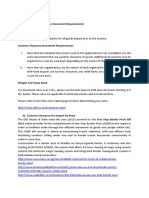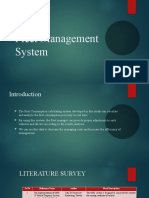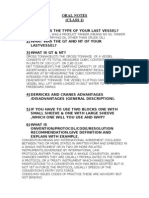Port Management System: Features
Port Management System: Features
Uploaded by
Farhan Khan NiaZiCopyright:
Available Formats
Port Management System: Features
Port Management System: Features
Uploaded by
Farhan Khan NiaZiOriginal Description:
Original Title
Copyright
Available Formats
Share this document
Did you find this document useful?
Is this content inappropriate?
Copyright:
Available Formats
Port Management System: Features
Port Management System: Features
Uploaded by
Farhan Khan NiaZiCopyright:
Available Formats
Port management system
Large ports need to deal with a number of disparate activities: the movement of ships, containers and other cargo, the loading and unloading of ships and containers, customs activities. As well as human resources, anchorages, channels, lighters, tugs, berths, warehouse and other storage spaces have to be allocated and released. The efficient management of a port involves managing these activities and resources, managing the flows of money involved between the agents providing and using these resources, and providing management information.
Features: This system captures entire operations right from documentation to delivery it include features like registration of ship and vessels when they enter the port, then it creates and record a complete Pilot schedule and Berthing process of that particular ship, production of automated Invoice or a Rate Card with a record of all services offered to a vessel. The system then creates a dashboard to view entire marine operations with real time information.
Operations
Marine Operations Allows the user to effectively and efficiently manage Marine operations such as Anchorage, Pilotage, Berthing, Unberthing, It also caters to systemized management for vessel arrival or departure and movement status in the port, berth management, automatic invoice generation or calculation of port dues and services requested, etc. Cargo Operations Provides a solution for the smooth management of import and export process documentation and helps to plan, allocate, schedule, control and monitor all cargo operations to maximize their productivity and efficiency. The application captures the activities and functions of Gate, Warehouse and Rail. Vessel Operations It consists of documentation Vessel, Berth allocation and monitoring, recording and billing of services requested and finally preparation of vessel Dashboard. Vessel activities and cargo details are recorded and authorized users are able to input information directly to the system by a secure web interface. Information can also be sent in via email.
The berthing Tool gives a graphical view of the vessels and berths, providing the ability to accurately position vessels to specific berths. It also shows the identity and particulars of vessels at those locations.
Billing is calculation of services such as dockage, water, electricity, equipment usage, rents, delay penalties, storage and manpower time. System also manages customer specific commercial contract details.
Material Management: It consist of recording information like Vendor, Procurement Process, Purchasing & Invoicing, Inventory & Stores allocated and lists of goods Receipt or Issued or transferred. There are the main five types of materials namely Coal, Ore, Grain, Fertilizers and Oil and they also have further subdivisions. System also inform about hazards associated with the transport of certain materials.
Cargo & Logistics Management (CLMS): Ships are divided into different categories such as dry bulk cargo ships, general-purpose ships, liners and tankers, including Ore/Oil carriers. Tankers are sub-divide into several categories including carriers for crude-oil, petroleum products, chemicals, liquid gases, vegetable oils etc. each type needs different type of berth features, holds, hatches, derricks, winches, cranes and other cargo handling gear. The system helps in identifying that how particular ship types are allocated for the different cargoes and trade routes. When a vessel arrives firstly its Import / Export Documentation is done then different Warehouse shipping operations are suggested according to cargo types. Storage Planning is important and it also varies from ship to ship on the basis of material carriage.
Customs & EDI: In this step system records information regarding Importer / Exporter and what they are shipping. Data is configured into useful information like dockage, warehouses, services and rates which is transferred over the network. Both port managers and external users can access this information through a secure network. Some part of this info is also used by custom authorities or coast guards for checking ships and their materials.
Operations Resource Management (ORM): This feature assists in creation of Personnel Calendar which includes personnel deployment for port operations. Current practices in the deployment/assignment of workers include the following:
a. Rotation b. Per Work Schedule c. First-come/First-serve scheme
The majority of the ports make use of the first two schemes either exclusively or in combination. The third is practiced in certain ports in the Philippines and Indonesia.
ORM includes Labor Requisition/Allocation, Work Order Generation/Finalization/Approval and Equipment Requisition/Allocation/Recording. It record allocation of different cargo handling equipment, types and their costs.
Finance Management System: It is maintenance and recording of financial information in port operations, budgets, capital and revenue expenditures and investment appraisal. It includes the analysis and monitoring of costs and port cost accounting. This system helps in corporate analysis of financial data and for budgetary planning and control. This feature is used for Automated Invoicing/Billing of all services and charges for port operations of particular vessel. This system also performs bill adjustments if there any mistake in the bill. Furthermore this system also keeps records of customer service agreements and cash/bank transactions.
Rail Operations Management System: Some ports also have rail system for transportation of cargos from port to their destinations. Rail management activities include Rail documentation includes information of materials being transported and their destination. A Wagon (rail compartment) is allotted to goods according to their nature and route. Exchange Yard Operations are recorded at both loading and unloading of luggage. This is actually handing over of materials from one authority (port) to other (customer).
Administration & User Customization: A god port management system should be able provide complete port administration for Port authorities by covering and performing all port operations. It should have easy to use web interface. A User based Application & Setup Customizations is also required because port face different type of customers varying from single person to large multinational companies and there are different types of materials and cargo brought to port in different
type of ships and vessels. All of them need different services by type and amount which will lead to different amount of charges.
Usefulness of PMS: It helps in smooth management of vessel arrival/departure and cargo handlings by transferring and using information about vessel, cargo and port facilities via information network linking users. Preventing unexpected accidents by monitoring vessel movements (arrival/departure, Berthing) and port facilities management information. Enabling effective use of limited port facilities by providing port facilities management status information on a real-time basis. Increase users credibility on port operation by providing paperless administration by storing data electronically. Users do not need to visit the governmental organizations this is done automatically by fast port operation information services provided by PMS network.
References:
http://r0.unctad.org/trainfortrade/euframes/ptpen/M5b_demo_PM_v2007.pdf?id=2106 http://freedownload.is/pdf/modern-port-management-7349154.html
You might also like
- Haccp Plan For Honey Production Uk BlankDocument9 pagesHaccp Plan For Honey Production Uk BlankRobert RubiellaNo ratings yet
- Moss - Earth AUP Report 2021 Final ExternalDocument15 pagesMoss - Earth AUP Report 2021 Final ExternalbrasildiversoNo ratings yet
- An Automated Transport Management System: Ms Mithlesh ChoudharyDocument5 pagesAn Automated Transport Management System: Ms Mithlesh ChoudharyJohn OluwaTobiNo ratings yet
- Logistics Management Analysis and DesignDocument58 pagesLogistics Management Analysis and DesignDrapeeto0% (1)
- Pressure Loss Equations PDFDocument18 pagesPressure Loss Equations PDFcperez10000No ratings yet
- Diploma in Management: Matriculation No: Identity Card No.: Telephone No.: E-Mail: Learning CentreDocument8 pagesDiploma in Management: Matriculation No: Identity Card No.: Telephone No.: E-Mail: Learning CentreSobanah ChandranNo ratings yet
- SAP Enabled RF GunDocument4 pagesSAP Enabled RF Gunvijay_sudha100% (2)
- ERP Maritime ERPDocument22 pagesERP Maritime ERPশারিকা নাহিদ100% (1)
- Container Terminal Management System (CTMS) : Synchronous Planning and Real Time Control System)Document9 pagesContainer Terminal Management System (CTMS) : Synchronous Planning and Real Time Control System)Mir Tareque AliNo ratings yet
- Security and Control Risk Assessment of Toll Bridge OperationsDocument3 pagesSecurity and Control Risk Assessment of Toll Bridge OperationsRaghu Vamsi0% (1)
- Uganda Customs Clearance Document RequirementsDocument6 pagesUganda Customs Clearance Document RequirementsEdgar MugaruraNo ratings yet
- Security and Control Risk Assessment of Toll Bridge OperationsDocument2 pagesSecurity and Control Risk Assessment of Toll Bridge OperationsMurukuri RavitejaNo ratings yet
- NBFC, Memo On Monitoring of TransactionDocument4 pagesNBFC, Memo On Monitoring of TransactionpradeepjypNo ratings yet
- SrsDocument16 pagesSrsTanvir DhanjuNo ratings yet
- Data Flow Diagram of A Cargo Management SystemDocument50 pagesData Flow Diagram of A Cargo Management SystemRamavtar NishadNo ratings yet
- Design and Implementation of A Fleet Management Sy PDFDocument8 pagesDesign and Implementation of A Fleet Management Sy PDFrashaNo ratings yet
- Duty Drawback SchemeDocument3 pagesDuty Drawback SchemeganariNo ratings yet
- SCM Unit 3Document96 pagesSCM Unit 3struthika DNo ratings yet
- Vtmis X VTS: Vessel Traffic Service (VTS)Document4 pagesVtmis X VTS: Vessel Traffic Service (VTS)Satya Prakash Bhardwaj100% (1)
- Air Cargo Clearance Proceedure.Document4 pagesAir Cargo Clearance Proceedure.Mukesh TengliNo ratings yet
- Vital Event Management SystemDocument16 pagesVital Event Management Systemtsbaye WaNo ratings yet
- Passport Service SystemDocument23 pagesPassport Service SystemSaurabh AgarwalNo ratings yet
- What Are Legal Issues in Logistics?Document5 pagesWhat Are Legal Issues in Logistics?Abhishek TiwariNo ratings yet
- Echnical AND Usiness RitingDocument10 pagesEchnical AND Usiness RitingRafshan ImbisaatNo ratings yet
- On The Amlock System of The Bank: Natural (Individual) CustomersDocument2 pagesOn The Amlock System of The Bank: Natural (Individual) CustomersDaniel AT GonfaNo ratings yet
- goAMLSchema-v5 0 2Document76 pagesgoAMLSchema-v5 0 2Aldige AfonsoNo ratings yet
- Imps Recon FaqsDocument2 pagesImps Recon FaqsGirish SasidharanNo ratings yet
- Indian Customs Manual - Procedure For Clearance of Imported and Export Goods PDFDocument5 pagesIndian Customs Manual - Procedure For Clearance of Imported and Export Goods PDFshivam_dubey4004No ratings yet
- Cargo Management System - ColorfulDocument7 pagesCargo Management System - ColorfulAssadNo ratings yet
- Quality Management ProcessesDocument9 pagesQuality Management Processesselinasimpson0701No ratings yet
- Regional Maritime University: Port Performance IndicatorsDocument92 pagesRegional Maritime University: Port Performance IndicatorsVictor Ose MosesNo ratings yet
- Bonded WarehousingDocument5 pagesBonded Warehousingsidd_quest8585No ratings yet
- FeaturesDocument2 pagesFeaturesMuhammad Aftab Masood FASTNUNo ratings yet
- Guidelines For The Licensing and Operation of Forex Bureaus and Money Remmittance Companies 2018Document10 pagesGuidelines For The Licensing and Operation of Forex Bureaus and Money Remmittance Companies 2018wandalexNo ratings yet
- KwaMoja Manual PDFDocument638 pagesKwaMoja Manual PDFerlanvrNo ratings yet
- Implementation of SAP and Integration of Port Operations System 1Document33 pagesImplementation of SAP and Integration of Port Operations System 1Rakesh HNo ratings yet
- Xcel Cover Letter To Boulder Requirements RFP ResponseDocument3 pagesXcel Cover Letter To Boulder Requirements RFP ResponseMatt SebastianNo ratings yet
- Single Customs TerritoryDocument4 pagesSingle Customs TerritoryURAugandaNo ratings yet
- Chapter 5 PPEDocument54 pagesChapter 5 PPEswarna dasNo ratings yet
- Immigration ClearanceDocument92 pagesImmigration Clearanceindia_proud50% (4)
- Strategic Tax Planning and ManagementDocument37 pagesStrategic Tax Planning and Managementle youtuber classicNo ratings yet
- OB Assignment SrsDocument11 pagesOB Assignment SrsQasimNo ratings yet
- Process Payments GÇô Manual Receipts and Manual Receipt Batches PDFDocument49 pagesProcess Payments GÇô Manual Receipts and Manual Receipt Batches PDFbala.oracleappsNo ratings yet
- An Airport Flights Database System ReportDocument25 pagesAn Airport Flights Database System ReportBilbil IsmaNo ratings yet
- Tour and Trave Management SystemDocument33 pagesTour and Trave Management SystemMisgana TerefeNo ratings yet
- Fleet Management System (Final)Document17 pagesFleet Management System (Final)Vedant GhavateNo ratings yet
- R12 ReportsDocument176 pagesR12 ReportsStacey BrooksNo ratings yet
- Placement Office Automation: Bachelor of TechnologyDocument57 pagesPlacement Office Automation: Bachelor of TechnologySrimanik KamarapuNo ratings yet
- Output PrimitivesDocument20 pagesOutput Primitivesvijay_dhawaleNo ratings yet
- Courier ReportDocument12 pagesCourier ReportLanre BouncingNo ratings yet
- 6 2Document10 pages6 2NavaneethReddy100% (1)
- Customs Clearance Proceedure - GhanaDocument17 pagesCustoms Clearance Proceedure - Ghanasaisridhar99No ratings yet
- Number Portability GatewayDocument4 pagesNumber Portability GatewaytoofanvandaNo ratings yet
- Kenya Freight Clearance and Forwarding Proceedures - Aeromarine Capital - Freight Clearing Forwarding KenyaDocument7 pagesKenya Freight Clearance and Forwarding Proceedures - Aeromarine Capital - Freight Clearing Forwarding KenyaPriyadarshi BhaskarNo ratings yet
- Medical Information Management SystemsDocument77 pagesMedical Information Management SystemsDan GiorgeNo ratings yet
- Warehouse Management System: Use CaseDocument3 pagesWarehouse Management System: Use CaseLakshanmayaNo ratings yet
- Visvesvaraya Technological University: K.S.Institute of TechnologyDocument38 pagesVisvesvaraya Technological University: K.S.Institute of TechnologyRekha VenkatpuraNo ratings yet
- OOAD Midterm2020 QuestionsDocument12 pagesOOAD Midterm2020 QuestionsNguyễn Tiến ĐứcNo ratings yet
- Inventory Master File: Lecture Topic: During The Lecture, Take Notes Here. Insert A Sub-Page For Each Lecture TopicDocument3 pagesInventory Master File: Lecture Topic: During The Lecture, Take Notes Here. Insert A Sub-Page For Each Lecture TopicpalaviyaNo ratings yet
- Service ChargesDocument56 pagesService ChargesAshokkumar Madhaiyan0% (1)
- Indian Railways FOISDocument9 pagesIndian Railways FOISSagar GuptaNo ratings yet
- CASE STUDY PSA Cruising With Information SystemDocument4 pagesCASE STUDY PSA Cruising With Information SystemMinh NguyênNo ratings yet
- 14feb2023 SC-1Document8 pages14feb2023 SC-1Razaur RahmanNo ratings yet
- Procedure and Documentation in Supply Chain Management: Business strategy books, #1From EverandProcedure and Documentation in Supply Chain Management: Business strategy books, #1No ratings yet
- Annex2 Website1702131007Document144 pagesAnnex2 Website1702131007Farhan Khan NiaZiNo ratings yet
- New Microsoft Office Word DocumentDocument18 pagesNew Microsoft Office Word DocumentFarhan Khan NiaZiNo ratings yet
- Scholarship Application Form (USAID)Document9 pagesScholarship Application Form (USAID)Farhan Khan NiaZiNo ratings yet
- Merit Testing Service-Pakistan: A Symbol of Merit in Testing and AssessmentDocument2 pagesMerit Testing Service-Pakistan: A Symbol of Merit in Testing and AssessmentFarhan Khan NiaZiNo ratings yet
- Chap 5 PMEDocument48 pagesChap 5 PMEFarhan Khan NiaZiNo ratings yet
- Mexico Application Form 2015Document4 pagesMexico Application Form 2015Farhan Khan NiaZiNo ratings yet
- Chapter 1Document2 pagesChapter 1Farhan Khan NiaZiNo ratings yet
- 2NDDocument1 page2NDFarhan Khan NiaZiNo ratings yet
- Submitted To:-Dr. Ali Sohaib Submitted By: - Muhammad Farhan Khan CIIT/Fa12-bet-049/Isb Section Bet (6B)Document1 pageSubmitted To:-Dr. Ali Sohaib Submitted By: - Muhammad Farhan Khan CIIT/Fa12-bet-049/Isb Section Bet (6B)Farhan Khan NiaZiNo ratings yet
- Chapter (Eng. Eco) 007Document16 pagesChapter (Eng. Eco) 007Farhan Khan NiaZiNo ratings yet
- Lab No 3Document4 pagesLab No 3Farhan Khan NiaZiNo ratings yet
- Audio Equalizer:: M. Junaid Khan FA12-BET-005 M. Farhan Khan FA12-BET-049Document2 pagesAudio Equalizer:: M. Junaid Khan FA12-BET-005 M. Farhan Khan FA12-BET-049Farhan Khan NiaZiNo ratings yet
- EE Time Table Spring 15Document80 pagesEE Time Table Spring 15Farhan Khan NiaZiNo ratings yet
- Syedbilal@comsats Edu PKDocument1 pageSyedbilal@comsats Edu PKFarhan Khan NiaZiNo ratings yet
- Short Keys f1-f12Document2 pagesShort Keys f1-f12Farhan Khan NiaZiNo ratings yet
- Recursive Estimation: Problem Set 2: Bayes' Theorem and Bayesian TrackingDocument13 pagesRecursive Estimation: Problem Set 2: Bayes' Theorem and Bayesian TrackingFarhan Khan NiaZiNo ratings yet
- Quiz 3 SolutionDocument3 pagesQuiz 3 SolutionFarhan Khan NiaZiNo ratings yet
- EEE223 Lec5 HandoutsDocument4 pagesEEE223 Lec5 HandoutsFarhan Khan NiaZiNo ratings yet
- Printing Business For SaleDocument9 pagesPrinting Business For SaleSMM DATANo ratings yet
- Hisense PDFDocument2 pagesHisense PDFAdnan AdilNo ratings yet
- AN3968 Application Note: STM32F407/STM32F417 In-Application Programming (IAP) Over EthernetDocument19 pagesAN3968 Application Note: STM32F407/STM32F417 In-Application Programming (IAP) Over EthernetcqlNo ratings yet
- Tutorial 11Document1 pageTutorial 11ankitNo ratings yet
- Individual Development Plan Template RRCDocument3 pagesIndividual Development Plan Template RRCMark Dexter Mejia50% (2)
- Mechatest Steam Sample Conditioning - LPMTDocument2 pagesMechatest Steam Sample Conditioning - LPMTGuerreros TerrandinaNo ratings yet
- PC200-8 PC200LC-8 S N B30001-UP AtualDocument602 pagesPC200-8 PC200LC-8 S N B30001-UP AtualAdmilson RodriguesNo ratings yet
- BQ Rumah SRK Kolej Seroja (Wifi)Document2 pagesBQ Rumah SRK Kolej Seroja (Wifi)shah4250No ratings yet
- LECTURE 7 - Chapter 10 Auditing The Revenue ProcessDocument35 pagesLECTURE 7 - Chapter 10 Auditing The Revenue Processamy100% (1)
- Eclipse 100 Introductory Course: Course Tutor: Eric Mackay 12 January 2007Document35 pagesEclipse 100 Introductory Course: Course Tutor: Eric Mackay 12 January 2007Anshul JhaNo ratings yet
- Swat 4 CheatsDocument1 pageSwat 4 CheatsgalhardoroNo ratings yet
- Sameer Vs NLRCDocument2 pagesSameer Vs NLRCRevz Lamoste100% (1)
- Marketing-Strategy-Chapter-1 P3Document7 pagesMarketing-Strategy-Chapter-1 P3Fouad guennouniNo ratings yet
- Yes Private Credit Card MITC PDFDocument8 pagesYes Private Credit Card MITC PDFkiran sai100% (1)
- Curriculum Guide: Instructional PlanningDocument3 pagesCurriculum Guide: Instructional PlanningJoana Pauline SimafrancaNo ratings yet
- 5T Eur To 5 Box 1T DR.M&P2112Document7 pages5T Eur To 5 Box 1T DR.M&P2112seyede.fateme.alaei100% (1)
- Minge-Kalman - The Industrial Revolution and The European Family The Institutionalization of 'Childhood' As A Market For Family LaborDocument16 pagesMinge-Kalman - The Industrial Revolution and The European Family The Institutionalization of 'Childhood' As A Market For Family LaborXoxoOlveraNo ratings yet
- Regino v. Pangasinan Colleges of Science and TechnologyDocument2 pagesRegino v. Pangasinan Colleges of Science and TechnologyJG UdNo ratings yet
- SPM Kelompok 1Document33 pagesSPM Kelompok 1Septiani PrayudiNo ratings yet
- Income InequalityDocument20 pagesIncome Inequalitymarve_gamboa1006No ratings yet
- Baliwag Transit, Inc. vs. Court of AppealsDocument2 pagesBaliwag Transit, Inc. vs. Court of AppealsAlmer TinapayNo ratings yet
- Specification For EquipmentsDocument6 pagesSpecification For EquipmentsChiranjivi KuthumiNo ratings yet
- Pdfs-83349 Airbnb ContractDocument3 pagesPdfs-83349 Airbnb Contractbaxter david100% (1)
- Theories of ImperialismDocument8 pagesTheories of ImperialismKelvin GuptaNo ratings yet
- Oral Notes (CLASS 1)Document68 pagesOral Notes (CLASS 1)raghasandeepNo ratings yet
- Inbound 4355567192394881701Document18 pagesInbound 4355567192394881701Ellicec CamreNo ratings yet











































































































